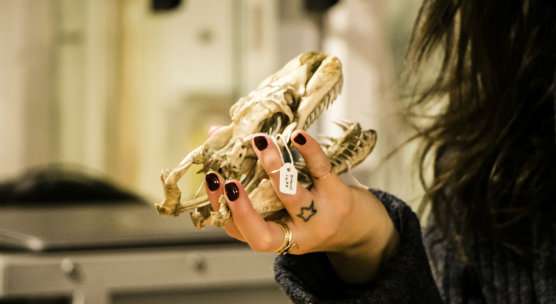Virtual museum brings extinct species back to life

Dozens of fascinating digital 3-D models are shedding new light on specimens held at the University of Dundee's D'Arcy Thompson Museum while enhancing the learning of anatomy students around the world.
State-of-the-art scanning and design techniques have been deployed to digitise prairie dogs, puffer fish and giant tortoises as well as the skulls of elephants, rhinoceroses and other items from the collection of D'Arcy Thompson, Dundee's celebrated first Professor of Biology.
The resulting 3-D models are hosted online and are available for viewing and downloading worldwide under a creative commons licence. This has led to one of the items, a skull thought to belong to an Indian Elephant, being reclassified as that of an African Forest Elephant following comments posted by an expert. The catalogue of models also includes the sectioned skull a Thylacine, otherwise known as the Tasmanian Wolf, an extinct species of carnivorous marsupial.
So far the models have been viewed over 10,000 times in more than 25 countries with over 1600 downloads having taken place. The digital collection is being used in a variety of learning and teaching initiatives around the world, including at the University of Queensland in Australia.
The project was instigated by Dr Caroline Erolin, MSc Medical Art course coordinator at the University's Centre for Anatomy and Human Identification (CAHID), who uses the museum's collection and facilities as part of her teaching practice.
"Every visit to the D'Arcy Thompson Zoology Museum throws up something else fascinating," she said. "My focus is on the future of medical art and artists, particularly in relation to new and developing technologies, and this gave me the opportunity to explore the collection further while also honing my 3-D scanning and modelling design skills. It's been incredible to see the models come to life, as it were.
"I worked on the project throughout 2016 whenever the opportunity arose. Smaller specimens were scanned with a micro CT scanner, while larger specimens (from around 20cm) were captured using hand-held structured light scanners. All the colour had to be added later in the process.
"I would love to scan and digitise every specimen in the museum but with there being thousands of them it just isn't possible. I worked with Matthew Jarron, the museum curator, to identify the most interesting specimens and those most relevant to D'Arcy Thompson's work and legacy."
This year marks the 100th anniversary of the publication of D'Arcy's seminal book, On Growth and Form, which has been hailed as "the greatest work of prose in twentieth century science". Through his iconic transformation diagrams, D'Arcy demonstrated that laws of growth rather than evolution could be used to explain the different forms of related species.
The book inspired scientists, artists and thinkers as diverse as Alan Turing, C. H. Waddington, Claude Lévi Strauss, Jackson Pollock and Norman Foster. It pioneered the science of biomathematics, and its influence in art, architecture, anthropology, geography, cybernetics and many other fields continues to this day.
Museum curator Matthew Jarron said, "This is a great way to make parts of D'Arcy Thompson's amazing collection more accessible to audiences around the world, particularly appropriate in this anniversary year when there is huge international interest in D'Arcy's work. We can also use the scans within the museum, by printing the models in 3-D so visitors can handle them."
Dr Erolin's students will now take the project forward by digitising more items from the collection and using a 3-D printer to produce copies of fragile specimens that can be used in teaching in multiple locations worldwide.
More information: The 3D models can be viewed at www.dundee.ac.uk/museum/collec … s/zoology/zoology3d/
Provided by University of Dundee





















